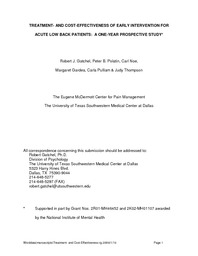
ATTENTION: The works hosted here are being migrated to a new repository that will consolidate resources, improve discoverability, and better show UTA's research impact on the global community. We will update authors as the migration progresses. Please see MavMatrix for more information.
Show simple item record
| dc.contributor.author | Gatchel, Robert J. | |
| dc.contributor.author | Polatin, Peter B. | |
| dc.contributor.author | Noe, Carl | |
| dc.date.accessioned | 2010-08-11T20:11:40Z | |
| dc.date.available | 2010-08-11T20:11:40Z | |
| dc.date.issued | 2003-03 | |
| dc.identifier.citation | Published in Journal of Occupational Rehabilitation 13:1-9, 2003 | en_US |
| dc.identifier.uri | http://hdl.handle.net/10106/5015 | |
| dc.description | Author's final draft after peer review, also known as a post print. | en_US |
| dc.description.abstract | In an attempt to prevent acute low back pain from becoming a chronic disability problem, an earlier study developed a statistical algorithm which accurately identified those acute low back pain patients who were at high risk for developing such chronicity. The major goal of the present study was to evaluate the clinical effectiveness of employing an early intervention program with these high-risk patients in order to prevent the development of chronic disability at a one-year follow-up. Approximately 700 acute low back pain patients were screened for their high-risk versus low-risk status. On the basis of this screening, high-risk patients were then randomly assigned to one of two groups: a functional restoration early intervention group (n=22), or a non-intervention group (n=48). A group of low-risk subjects (n=54) who did not receive any early intervention was also evaluated. All these subjects were prospectively tracked at 3-month intervals starting from the date of their initial evaluation, culminating in a 12-month follow-up. During these follow-up evaluations, pain disability and socioeconomic outcomes (such as return-to-work and healthcare utilization) were assessed. Results clearly indicated that the high-risk subjects who received early intervention displayed statistically significant fewer indices of chronic pain disability on a wide range of work, healthcare utilization, medication use, and self-report pain variables, relative to the high-risk subjects who do not receive such early intervention. In addition, the high-risk non-intervention group displayed significantly more symptoms of chronic pain disability on these variables relative to the initially low risk subjects. Cost-comparison savings data
Worddata\manuscripts\Treatment- and Cost-Effectiveness-rg.209\6/1/10 Page 3
were also evaluated. These data revealed that there were greater cost savings associated with the early intervention group versus the no early intervention group. The overall results of this study clearly demonstrate the treatment- and cost-effectiveness of an early intervention program for acute low back pain patients. The study represents the first of its type and clearly demonstrates the therapeutic and financial advantages of an early intervention approach to acute low back pain disability. | en_US |
| dc.description.sponsorship | Supported in part by Grant Nos. 2R01-MH46452 and 2K02-MH01107 awarded by the National Institute of Mental Health | en_US |
| dc.language.iso | en_US | en_US |
| dc.publisher | Springer Science & Business Media B.V. | en_US |
| dc.subject | acute low back pain | en_US |
| dc.subject | cost effectiveness | en_US |
| dc.subject | early intervention | en_US |
| dc.subject | functional restoration | en_US |
| dc.subject | treatment effectiveness | en_US |
| dc.title | Treatment- and Cost-Effectiveness of Early Intervention for Acute Low Back Patients: A One-Year Prospective Study | en_US |
| dc.type | Article | en_US |
| dc.publisher.department | Department of Psychology, The University of Texas at Arlington | en_US |
| dc.identifier.externalLinkDescription | The original publication is available at article DOI | en_US |
| dc.identifier.doi | http://dx.doi.org/10.1023/A:1021823505774 | |
Files in this item
- Name:
- Gatchel Treatment-and Cost-Eff ...
- Size:
- 108.5Kb
- Format:
- PDF
- Description:
- PDF
- Name:
- Gatchel Treatment-and Cost-Eff ...
- Size:
- 30.96Kb
- Format:
- Text file
- Description:
- Text
This item appears in the following Collection(s)
Show simple item record


